Sea of Galilee
Also known as Bahr Tubariya, Ginnosar, Lake of Galilee, Lake of Gennesaret, Lake of Gennesar, Sea of Chinnereth, Sea of Chinneroth, Sea of Kinnereth, Sea of Tiberias, Lake of Tiberias, Waters of Gennesaret, Yam Kinneret
|
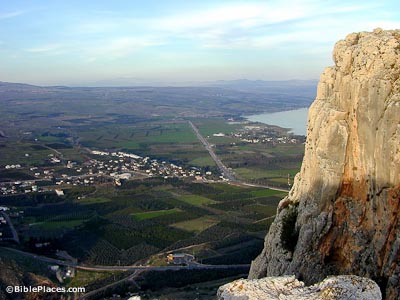 |
Plain of Gennesaret
The Plain of Gennesaret spreads out below the Arbel cliffs. About five miles long and two miles wide, this stretch of land alongside the Sea of Galilee's northwest shore was renowned for its fertility. Josephus wrote that it was "wonderful in its characteristics and in its beauty. Thanks to the rich soil there is not a plant that does not flourish there, and the inhabitants grow everything: the air is so temperate that it suits the most diverse species."
|
View from Northwest
The Sea of Galilee is fed by the Jordan River, rainfall and springs on the northern side. More properly designated a lake, the Kinneret (the OT and modern name) is 13 miles long and 7 miles wide. At its deepest point the lake is only 150 feet deep. The rabbis said of it, "Although God has created seven seas, yet He has chosen this one as His special delight."
| 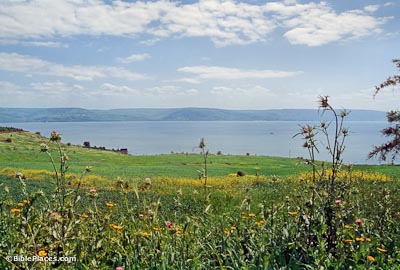 |

| View from Arbel |
| From the summit of Mount Arbel on the western side of the Sea of Galilee, one can see the entire lake, the city of Tiberias, the mountains of Galilee, and the Golan Heights. On a clear day, Mount Hermon is visible. |
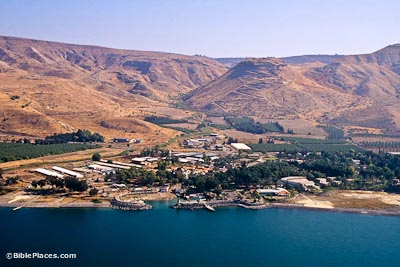 |
Hippos and Harbors
Hippos (Susita) was a major city of the Decapolis located on a round hill overlooking the shore. The modern harbor of Kibbutz En Gev is visible below it. In the first century, at least 16 harbors were located on the lake. All the lake's settlements had their own harbor, even if it was very small. The largest one belonged to Gadara had a 200 meter breakwater.
|
Wooden Boat Reconstruction
In 1986 a wooden vessel from the first century was discovered near Nof Ginosar on the lake's northwestern shore. Studies have determined the type of wood that was used (mainly cedar and oak), the style of construction (mortise and tenon joints), the date (on the basis of construction techniques, pottery and Carbon 14 tests) and the size (26 by 7 feet - big enough for 15 men). Pictured at right is a reconstruction of what the ancient boat might have looked like. This was formerly on display at Kibbutz En Gev.
| 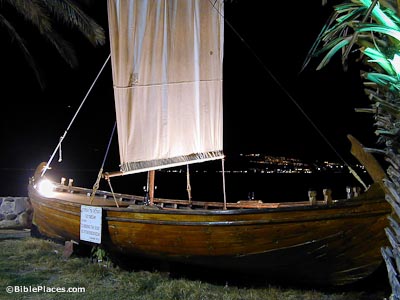 |
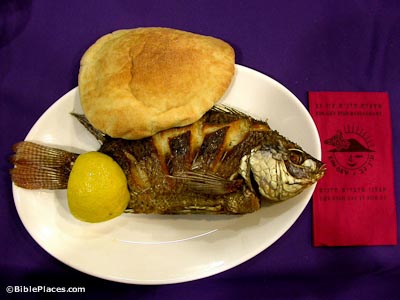 |
St. Peter's Fish
Three types of fish were primarily sought by fishermen in antiquity in these waters. Sardines likely were the "two small fish" that the boy brought to the feeding of the 5000. Sardines and bread were the staple product of the locals. Barbels are so known because of the barbs at the corners of their mouths. The third type is called musht but is more popularly known today as "St. Peter's Fish." This fish has a long dorsal fin which looks like a comb and can be up to 1.5 feet long and 3.3 lbs in weight.
|
Sunset
The peaceful calm of the Sea of Galilee can quickly become transformed by a violent storm. Winds funnel through the east-west aligned Galilee hill country and stir up the waters quickly. More violent are the winds that come off the hills of the Golan Heights to the east. Trapped in the basin, the winds can be deadly to fishermen. A storm in March 1992 sent waves 10 feet high crashing into downtown Tiberias and causing significant damage.
| 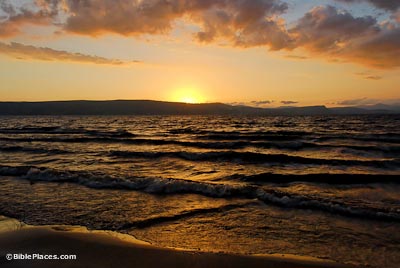 |

No comments:
Post a Comment